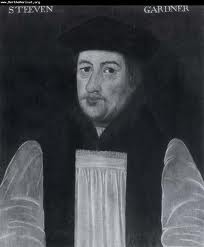Bishop Stephen Gardiner & the Reformation: The doctrine of the Mass

This another undated portrait from the later period of Gardiner’s long career at the top of tudor politics
Once the regular clergy and chantry priests were stripped of office and from the clerical estate; once images, statues, rood screens and side-altars were stripped from the churches; the Christocentric nature of Renaissance Humanism came clearly into focus. The old protagonists Archbishop Thomas Cranmer and Bishop Stephen Gardiner responded in a different ways to the sharpened perspective.
Cranmer’s reconsiderations of his considered doctrinal positions set him on a fresh course; he steered away from Luther’s beliefs. He used Calvin’s Institutes to inform a thoroughgoing reappraisal of dogma and doctrine based upon the sole authority of Scripture, freshly revealed in its original Hebrew, Aramaic and Greek, whilst all the time holding ever more firmly to the Supremacy as defined by his sometime rival Bishop Gardiner. Cranmer’s theology turned inwards; hide-bound to words in the narrow, refined, defined sense. In a odd way Cranmer became more like the despised canon lawyer but instead of trifling over words in briefs and dispensations; he worried over precise meanings of a phrase in Greek. His notion of justification and salvation became more like Calvin’s. By the time he wrote the Forty Two Articles in 1553 Cranmer’s Christianity was at least as committed to Predestination as Calvin’s and his Eucharistic theology had moved beyond Calvin’s notion of Real Spiritual Presence towards Zwinglian memorialism augmented by the notion of feeding on the communion bread with faith-in-your-heart.
The voyage of discovery taken by humanist reformers sympathetic towards Luther after 1517 had circumnavigated a wide world of Christian belief. Their journey discovered new meanings in the original languages of the books of the Old and New Testaments; they looked afresh at what they took to be the forgotten country of the Early Church; they looked to its practices and ritual for authentic signs of Christian simplicity; they derided errors of translation in the Vulgate of St Jerome; they dismissed the ideas of Aquinas; they denounced all later doctrinal accretions attributed to scholasticism. In the 1540′s; amongst the reformers, in England and elsewhere; in the aftermath of the Supremacy and dissolutions; in the light of the vernacular bible and Calvin’s Institutes; as a vernacular liturgy became the objective of the English reformers, the Eucharist became once more salient…..Continued Here
